Fagoting is an exquisite sewing technique that imparts a delicate, lacy touch to garments and textiles. Rooted in centuries of craftsmanship, it involves joining two pieces of fabric with evenly spaced, parallel stitches.
This method creates openwork patterns, resulting in a fine, decorative seam. Fagoting finds its place in heirloom sewing, lingerie, and fine apparel, adding an element of refined elegance.
Its versatility allows for customization, making it a cherished skill among sewists seeking to imbue their creations with a timeless, handcrafted aesthetic.
From bridal gowns to intricate linens, fagoting showcases the artistry and attention to detail that define exceptional sewing.
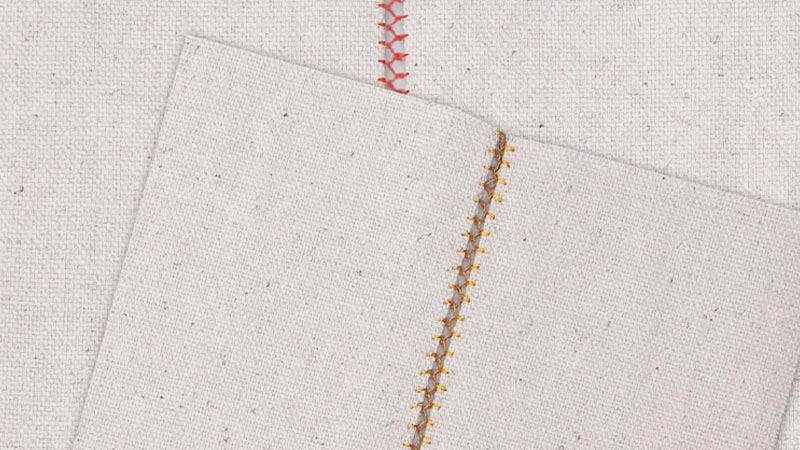
What Is Fagoting in Sewing?
Fagoting is a decorative sewing technique that combines two pieces of fabric with a series of evenly spaced, parallel stitches. The result is a delicate and openwork pattern.
Fagoting is often used in heirloom sewing, lingerie, and other fine garments to create a delicate and decorative seam.
Here’s how fagoting is typically done:
Preparing the Fabric
Ensure that both pieces of fabric have finished edges. This can be achieved through techniques like serging (overlocking), pinking (cutting with a zigzag edge), or creating a narrow hem.
This step is crucial to prevent fraying and maintain the overall integrity of the fabric.
Marking the Stitch Lines
Use a fabric marker or chalk to mark even intervals along the edges where you plan to apply the fagoting.
The spacing can vary depending on the desired aesthetic and the weight of the fabric. Clear intervals may be more appropriate for lightweight fabrics, while heavier fabrics may allow for wider spacing.
Creating the Stitches
Thread a needle with a thread color that complements your fabric. Begin by anchoring the thread on one side, then work a series of parallel stitches across the gap between the two pieces of fabric.
These stitches can vary in style, ranging from a simple running stitch for a clean and minimalist look to more intricate embroidery stitches for a decorative effect.
Securing the Ends
To prevent unraveling, ensure you secure your stitches’ ends well. This can be done by tying knots, backstitching, or using other secure finishing techniques. Take extra care with this step to guarantee the longevity of your fagoting.
Pressing the Seams
Gently press the seam with an iron on a low heat setting. This helps to set the stitches and smooth out any wrinkles or puckering that may have occurred during the fagoting process. Be cautious, especially if you’re working with delicate or heat-sensitive fabrics.
Trimming Excess Fabric
Depending on your project, you may have excess fabric beyond the fagoting. Carefully trim it to your desired length, leaving enough allowance for any necessary finishing or hemming.
Purposes of Using Fagoting in Sewing
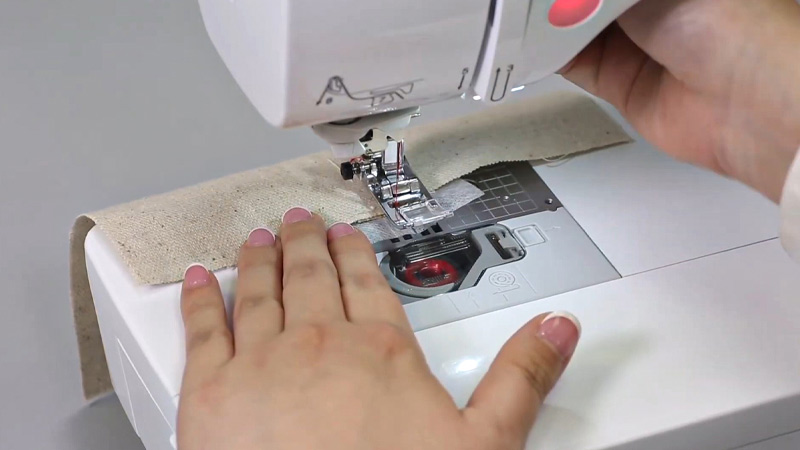
Using fagoting in sewing serves several purposes, both functional and decorative.
Here are some of the key purposes:
Decorative Detailing
Fagoting is a highly decorative technique that imparts elegance and intricacy to a garment or fabric project.
Its finely woven pattern adds a touch of sophistication, making it a favored choice for special occasions and heirloom-quality pieces.
The delicate nature of fagoting elevates the overall aesthetic, creating a visually appealing and timeless look.
Joining Delicate Fabrics
In sewing, certain fabrics demand a more refined approach to construction.
Lightweight and delicate fabrics like chiffon, organza, and lace require a technique that complements their ethereal qualities.
Fagoting provides a seamless and graceful solution, joining these fabrics with a finesse that preserves their delicate nature.
Creating Inserts
Fagoting offers a versatile means of incorporating inserts into a garment’s design. This technique seamlessly integrates these elements, whether lace strips, ribbons, or contrasting fabric.
Beyond the aesthetic appeal, fagoting reinforces the structural integrity of the garment, ensuring that inserts are securely held in place while contributing to an overall captivating visual contrast.
Adding Ventilation
Beyond its ornamental function, fagoting can serve a practical purpose by providing ventilation in specific garment areas.
This is particularly advantageous in regions that may become warm or stuffy during wear.
The openwork pattern of fagoting allows for improved airflow, enhancing comfort without compromising the garment’s overall design.
Heirloom Sewing
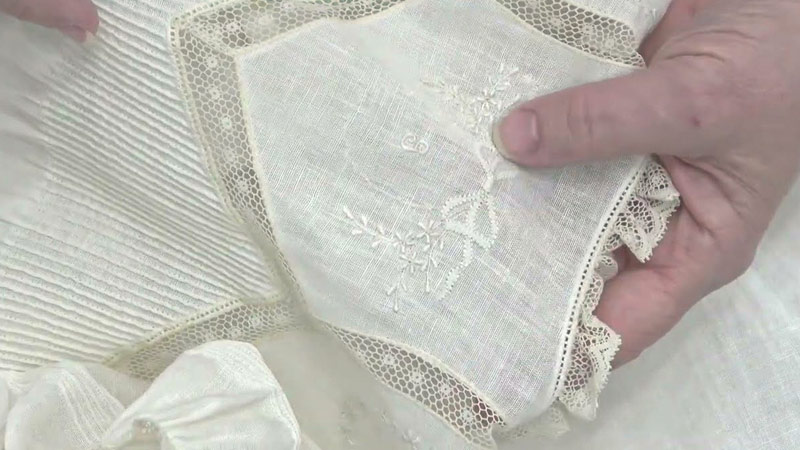
Fagoting holds a special place in the tradition of heirloom sewing. This meticulous craft involves creating garments or fabric projects of exceptional quality and craftsmanship, often intended to be cherished across generations.
Fagoting’s timeless and intricate appearance aligns perfectly with the values of heirloom sewing, resulting in pieces that hold sentimental value and are passed down as treasured family heirlooms.
Lingerie and Intimate Apparel
The delicate and feminine aesthetic of fagoting makes it a popular choice in the construction of lingerie, nightgowns, and other intimate apparel.
Its refined appearance complements the softness and intricacy often associated with such garments, ensuring a harmonious blend of function and aesthetics.
Special Occasion Garments
For garments designed for momentous occasions, such as wedding dresses or christening gowns, fagoting is a favored technique.
Its elegant and timeless look elevates these special garments, adding a touch of sophistication that complements the event’s significance.
Enhancing Necklines and Collars
Fagoting provides an exquisite means of finishing necklines, collars, and cuffs. Its fine detailing creates a polished and refined edge, elevating the overall appearance of the garment.
This technique adds a bespoke touch, ensuring that even the smallest details are executed precisely and carefully.
Hem Embellishments
Applying fagoting to hems allows for a decorative finish that complements the overall design of the garment.
Fagoting imparts a distinctive flair, transforming a basic hem into a beautifully adorned feature, whether used on sleeves, skirts, or other edges.
Customizing Home Decor
Fagoting isn’t confined solely to clothing. It can also be applied to home decor projects like curtains, pillowcases, and table linens.
This technique introduces an element of elegance and refinement, elevating the living space’s aesthetic.
Fine Children’s Clothing
In the realm of children’s clothing, particularly for infants and young children, fagoting is frequently employed to create intricate and detailed garments.
Its delicate appearance complements the innocence and charm of clothing for little ones, resulting in timeless pieces that are cherished for years to come.
Experimentation and Artistic Expression
Fagoting provides a canvas for creativity and experimentation in sewing.
This technique allows for unique and personalized designs, enabling sewers to push boundaries and explore innovative ways to incorporate fagoting into their projects.
Whether used unexpectedly or combined with other techniques, fagoting offers a platform for artistic expression and individuality in sewing.
Variations of Fagoting in Sewing

While traditional fagoting is a timeless technique, several variations add unique flair and character to your sewing projects. These variations provide opportunities for creativity and customization.
Here are some notable variations of fagoting:
Flat Fagoting
Flat fagoting is the quintessential variation of this technique. It involves creating parallel stitches to join two edges together seamlessly. This method results in a flat, lacy seam that exudes elegance.
The simplicity of flat fagoting allows it to complement a wide range of fabrics and garments, from lightweight summer dresses to delicate undergarments.
Woven Fagoting
Woven fagoting takes fagoting to a new level of intricacy. In this variation, threads are woven through the parallel stitches, creating a textured and decorative pattern.
Woven fagoting opens a world of design possibilities, from simple geometric shapes to intricate floral motifs. It’s an ideal choice when you want to add a touch of artistic flair to your sewing projects.
Lattice Fagoting
Lattice fagoting offers a structured and geometric take on the traditional technique.
It creates a grid-like pattern with the stitches, resulting in a more organized and symmetrical appearance.
This variation is perfect for projects that require clean lines and a polished finish, such as tailored blouses or shirts.
Shadow Work
While not strictly fagoting, shadow work is a technique that complements fagoting beautifully.
In shadow work, stitches design the fabric’s surface, often with a contrasting color underneath.
Combined with fagoting, it adds depth and dimension to the overall design, making it especially appealing for intricate embroidery and embellishment.
French Seam with Fagoting
Combining fagoting with a French seam is a delightful way to incorporate this technique into your sewing.
A French seam is a clean and enclosed seam, typically used with lightweight fabrics. Adding fagoting reinforces the seam and infuses it with a decorative element. This variation is both functional and visually appealing.
Applications of Fagoting in Sewing
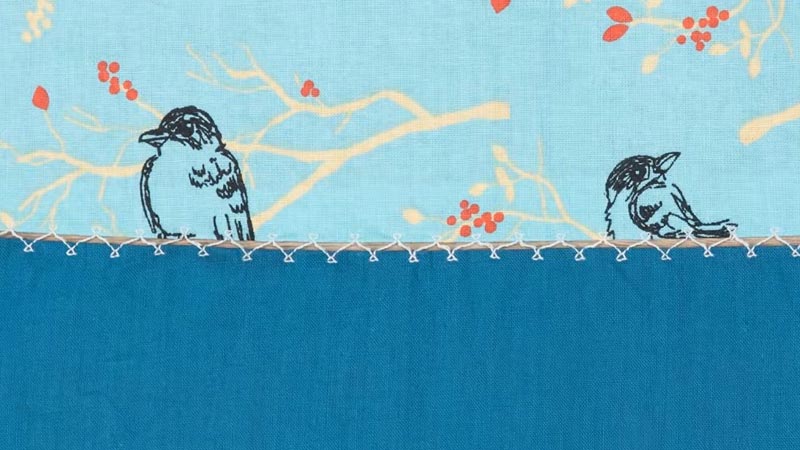
Fagoting is a versatile and decorative sewing technique that finds applications in various garment construction and embellishment aspects.
Here are some common applications:
Heirloom Sewing
Heirloom sewing is a cherished tradition that emphasizes creating garments with meticulous attention to detail and craftsmanship.
Fagoting plays a central role in this style, allowing for the joining of delicate fabrics like batiste, voile, and fine linens.
This technique creates a flat, lacy seam that exudes elegance and refinement, making it a perfect fit for garments meant to be treasured and passed down through generations.
Lingerie and Intimate Apparel
In the realm of lingerie, fagoting shines for its ability to delicately connect the often sheer and lightweight fabrics used in bras, panties, camisoles, and slips.
The fine, parallel stitches result in a seamless and barely noticeable seam, ensuring comfort and a luxurious feel against the skin.
This application of fagoting adds an extra layer of sophistication to intimate wear.
Children’s Clothing
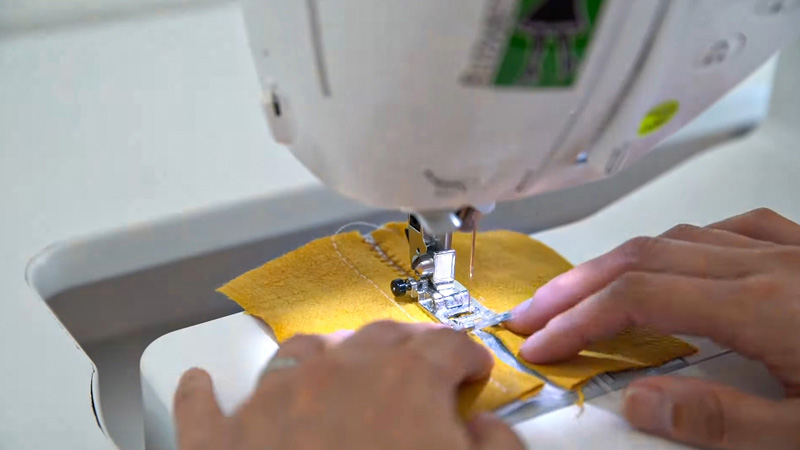
For special occasions and formal events, children’s clothing can be elevated by the inclusion of fagoting. Christening gowns, party dresses, and rompers often feature this technique.
The soft, delicate appearance of fagoting complements the innocence and sweetness of young children, creating garments that are beautiful and cherished keepsakes.
Bridal Wear
Bridal gowns and accessories are often crafted with ethereal fabrics like lace, chiffon, and organza. Fagoting provides a delicate, seamless join for these layers, allowing for a graceful flow and movement.
This application of fagoting contributes to the overall romantic and dreamy aesthetic of bridal attire, making it a popular choice for brides seeking a timeless, heirloom-quality gown.
Handkerchiefs and Scarves
Fagoting can transform simple accessories like handkerchiefs and scarves into exquisite pieces of functional art. These accessories take on an air of elegance by incorporating fagoting along the edges or as decorative inserts.
The fine craftsmanship involved in fagoting elevates these items from everyday essentials to cherished mementos.
Home Décor
Fagoting is not limited to garments; it can also be employed in home textiles. Curtains, tablecloths, napkins, and pillowcases can be adorned with fagoting to create decorative edges or inserts. This technique adds a touch of sophistication to home décor, turning functional items into beautiful accents that enhance the overall ambiance of a space.
Accessories
Incorporating fagoting into accessories like collars, cuffs, and pockets can elevate their design, transforming them from mere functional elements to standout features of a garment.
Additionally, hats and bags can be adorned with unique fagoting embellishments, showcasing the versatility of this technique beyond traditional seams.
Blouses and Shirts
Blouses and shirts made from lightweight fabrics benefit from the application of fagoting.
This technique provides a delicate and refined finish to the seams, ensuring the garment maintains a graceful drape and a polished appearance.
Fagoting adds a touch of sophistication to everyday wear, making it suitable for casual and more formal occasions.
Christening and Baptismal Gowns
Christening and baptismal gowns are significant garments that mark important milestones in a person’s life.
Fagoting is a popular choice for crafting these gowns, as it complements the soft and delicate fabrics often used for these special occasions.
The fine, lacy seam created by fagoting adds a timeless elegance to these cherished garments, ensuring they are treasured keepsakes for years to come.
Special Occasion Wear
Fagoting is a go-to technique for formal and special occasion wear. Fagoting adds a touch of sophistication and refinement, whether it’s an evening gown, a cocktail dress, or a formal suit.
By seamlessly joining layers of luxurious fabrics, fagoting enhances these garments’ overall look and feel, making them stand out at any event.
FAQs
What is fagoting in sewing?
Fagoting is a decorative sewing technique that involves joining two pieces of fabric with evenly spaced, parallel stitches. This creates an openwork pattern, resulting in a delicate and decorative seam.
What are common applications of fagoting?
Fagoting is commonly used in heirloom sewing, lingerie, children’s clothing, bridal wear, and various fine garments. It is also applied in accessories, home décor, and historical reproductions.
Are there different variations of fagoting?
Yes, there are several variations of fagoting. These include flat fagoting, woven fagoting, lattice fagoting, shadow work (combined with fagoting), and more. Each variation offers unique design possibilities.
What types of fabrics are suitable for fagoting?
Fagoting is typically used on lightweight and delicate fabrics like batiste, voile, chiffon, and lace. Choosing fabrics with finished edges is important to prevent fraying during the fagoting process.
How can I practice fagoting as a beginner?
It’s recommended to start with scrap fabric before fagoting on your project. Experiment with different stitch spacings and tensions to find what works best for your desired effect.
To Recap
Fagoting stands as a testament to the artistry and precision of sewing. Its delicate, parallel stitches create a timeless, lacy effect, elevating garments and textiles to a realm of refined elegance.
From heirloom pieces to intimate apparel, its applications are as varied as the fabrics it unites. Fagoting embodies a rich tradition, passed down through generations, and continues to be cherished in the world of fine craftsmanship.
As a versatile technique, it invites creativity and personalization, offering sewists the opportunity to add a distinctive touch to their creations.
With fagoting, every stitch tells a story of dedication to detail, resulting in garments that are beautiful and enduring in their charm.
Leave a Reply